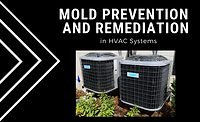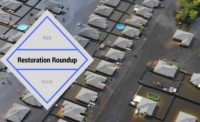Mold Remediation in HVAC Units: Dealing with Hurricane Flooding

Photo credit: Bilanol / iStock / Getty Images Plus via Getty Images
Each year, residents in the Caribbean and the southeast coast of the U.S. brace for hurricane season. Some years, residents breathe a sigh of relief that the storms stayed off in the Atlantic. Last year, thousands in Puerto Rico, Florida, and even Eastern Canada, did not have that luxury. Hurricanes Ian and Fiona left devastation in their wake. Current estimates put hurricane Ian’s damage at $114B. Hurricane Fiona stripped Puerto Rico of power for days. Together, the two storms resulted in over 156 deaths.
The effects of hurricane season are wide-ranging. Images of destroyed homes, neighborhoods, and cities fill the news. However, for some, they experience the devastation of a hurricane in a way that, although it doesn’t make the news, certainly makes an impact: mold, the aftermath of flooding.
As hurricanes approach, many homeowners and business owners wisely evacuate the area to protect themselves and their families. However, being far from home gives mold plenty of time to grow. With an incubation period of only 24-48 hours, stopping the spread of mold growth after hurricane flooding is extremely difficult. More often than not, after hurricanes strike, the task at hand is dealing with mold that has already grown rather than preventing it. Contractors face the challenge of not only having to remediate mold visible to the naked eye but also mold that has grown in spaces like HVAC systems. Tackling this challenge requires expertise.
Five steps to dealing with mold in HVAC units
1. Dry the building
Most molds require four things to survive: water, food, darkness, and temperatures above 50-60℉. Hurricanes provide ideal conditions for all four of these. The first step to dealing with mold after flooding is to extract the water. After a hurricane, there may be standing water throughout a building. To remove this, contractors use extraction equipment that functions as portable sump pumps and wet/dry vacuums. As mold thrives off moisture, removing the standing water is critical. Though this process begins with the flooring, it can extend to anywhere that water is sitting, HVAC systems included.
After removing large volumes of standing water with portable extraction equipment, contractors begin to dry the building using air movers. These air movers come in a variety of sizes, but all of them share the same goal: evaporate the water in the building. As air movers evaporate water into the air, it might get to a saturation point. In this case, dehumidifiers are used to pull the water out of the air. During this process of blowing air and dehumidifying, contractors should continually test various surfaces with monitors to check if surfaces are as dry as they should be.
2. Assess the mold growth
In some cases, specifically when mold growth is limited, assessing mold growth may be the first step. However, when there is extensive flooding after hurricanes and the question is not if there’s mold but how much mold, it can be better to begin with extracting water and drying the building before assessing the extent of mold growth. All the steps listed here require expertise; for this step, expertise comes from industrial hygienists.
Their expertise is necessary for a few reasons. First, if there is mold, everyone in the building should wear personal protective equipment (PPE), and many homeowners and business owners will not have access to this. Second, sighting mold is not always easy, and testing for it requires specialized equipment. For instance, a homeowner might notice mold around the HVAC vents, spray some chemicals on them, and assume they have solved the problem.
However, what shows on the outside is often only the tip of the iceberg. If there’s mold around the vents, it could very well be in the ductwork and furnace, not to mention the ceiling, floor joists, and drywall. And if these areas have mold, it’s highly likely that materials such as furniture, carpets, and drywall will as well because they are much more porous. Unfortunately, removing mold from these porous surfaces is very difficult; in most cases, drywall, furniture, and more will need to be torn out.
3. Contain the affected areas
Depending on how the water entered the building, mold growth could be localized. In this case, it’s critical to contain the spread of mold. If mold is inside parts of the ductwork, contractors must seal off HVAC vents around the affected areas to keep air from blowing into other rooms. Furthermore, contractors should establish negative pressure containment areas wherever they’re working on mold remediation. For instance, if they are remediating mold on an HVAC vent in the living room of a house, they could use modular containment walls or poly sheeting to seal off the area. Then, they would use a HEPA vacuum to pull the room under negative pressure, filter the air in the room, and exhaust the filtered air outside through ductwork.
4. Determine whether to replace or clean the affected HVAC materials
Just as drywall and other materials with porous surfaces may need to be removed, it's better to replace ductwork than remediating it in some cases. With flexible ductwork, removal is often necessary. However, metal ducting is more amenable to remediation. In some scenarios, even if contractors need to replace the ductwork, they can remediate the vents and plenum.
5. Remediate the mold
The final and most important step is remediating the mold. Contractors use a variety of techniques to do this. In areas that are easier to access, such as furnaces, HVAC units, and vents, contractors can use forced air machines to knock mold off the surfaces, then HEPA vacuums draw the mold spores in, filter them out of the air, and exhaust the clean air out of the contained area.
However, not all areas are easy to access. Ductwork specifically can be especially hard to reach. In these cases, air whips on long poles knock mold off the surfaces, and then HEPA vacuums capture the dirty air. In addition to these mechanical processes, there are also EPA-approved chemicals that contractors can spray into HVAC systems to kill the mold. When performing any of these tasks, and especially when using chemicals, it is vital to ensure that the affected area is sealed off from adjacent spaces.
Key considerations
The above steps outline the process of mold remediation in HVAC systems. However, as with most things, it’s easier said than done. When doing mold remediation, look for experts with relevant certifications and a track record of success. The IICRC provides industry standards for mold and flood remediation (S520 and S500, respectively). If a contractor isn’t familiar with these, find one who is.
Furthermore, make sure they’re equipped with the necessary air movers, dehumidifiers, HEPA vacuums, and more to do the job correctly. When it comes to mold, the principle of the tortoise and the hare rings true - slow and steady wins the race. Taking the time to do the job thoroughly always beats rushing through it and finding that the mold has continued to grow beneath the surface, creating an even more significant problem in the long run.
Looking for a reprint of this article?
From high-res PDFs to custom plaques, order your copy today!





